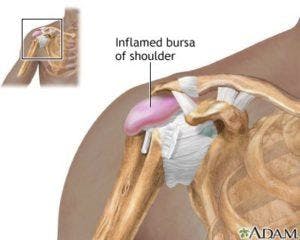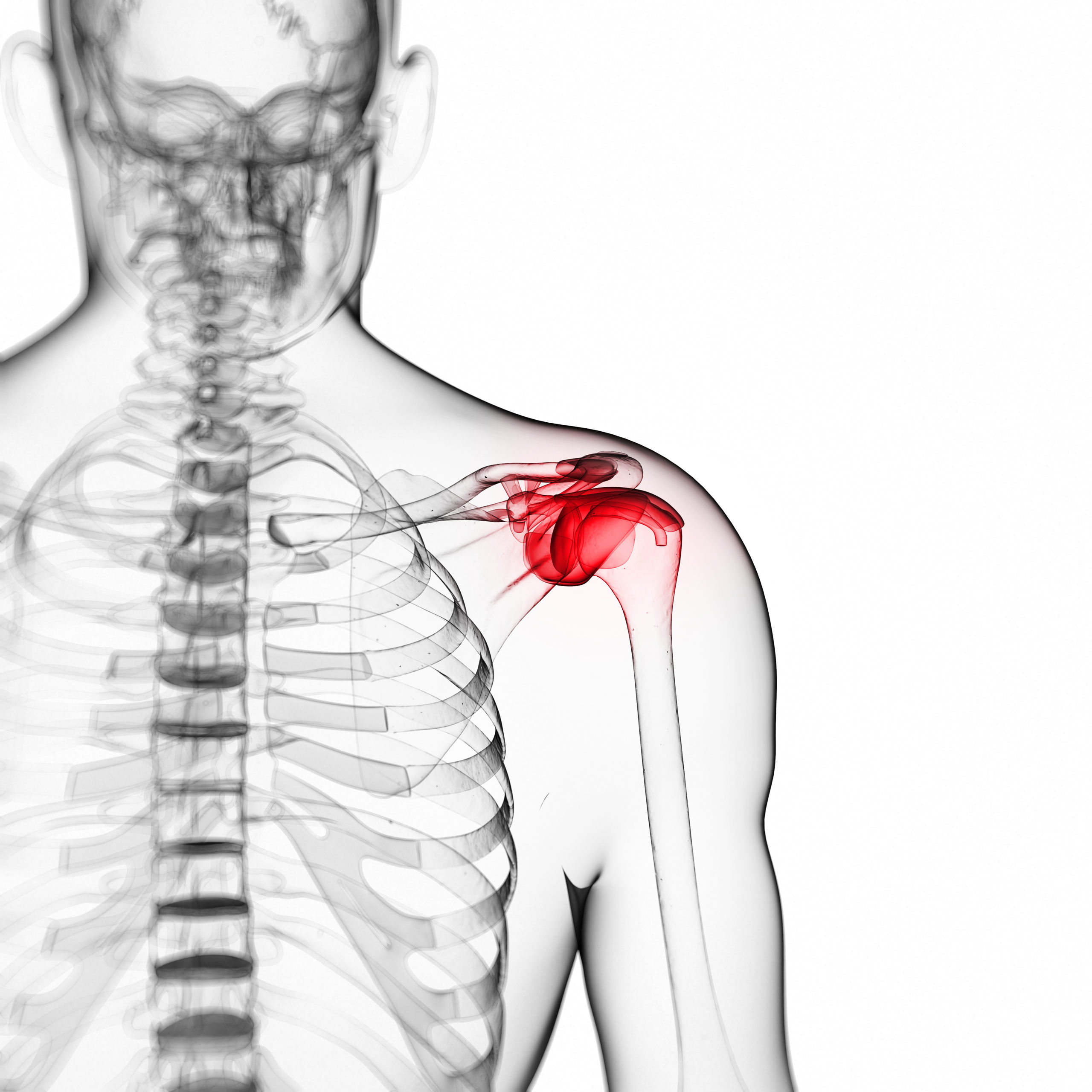Shoulders. They’re what you use to “shrug”, to throw, to reach, and sometimes even to “carry the weight of the world”! So when something goes wrong with your shoulder joint, you definitely notice a difference in your ability to perform all sorts of everyday movements that you usually don’t even think about.
Understanding Your Shoulder Joint
Your shoulder is a complex ball-and-socket joint that’s capable of flexion (bending), extension, rotation, and more. The fact is, your shoulder is the most mobile joint in your body! It’s surrounded by muscles, tendons, ligaments, bands of tissue like the rotator cuff and the labrum, plus some cushion-like tissue known as the subacromial bursa. A bursa is a thin, lubricated “cushion” that lies between a bone and an opposing surface such as a ligament, muscle or tendon. Its purpose is to reduce friction in a joint — in this case, your shoulder joint.

So What is Bursitis?
In the simplest of terms, bursitis refers to a painful condition that occurs when a bursa becomes inflamed. Since your shoulder’s bursa is the largest bursa in the body, and it is “packed” closely together with the other components that make up your shoulder, it is extremely susceptible to becoming inflamed. (By the way, simply because every part of your shoulder anatomy is so densely packed together, it’s not unusual for bursitis to be mistaken for something else like a rotator cuff tear, a labral tear, or even tendonitis!)
The subacromial bursa provides a cushion and reduces friction between the shoulder’s muscles and tendons and the acromion — the topmost part of your shoulder blade. But even though it’s the largest bursa providing cushioning in your shoulder joint, it’s not the only one. There are several others, including the subdeltoid bursa, the subscapular bursa, the subcoracoid bursa, the coracoclavicular bursa and the supra-acromial bursa. If anyone of these becomes irritated and inflamed, you’ve got shoulder bursitis!

Okay, But What’s Irritating My Shoulder Bursae?
Your shoulders’ bursae can be irritated and become inflamed by a number of different things, including:
- friction caused by repetitive overhead motions that occur when you’re painting the bathroom ceiling, for example, or maybe you’re a swimmer who’s specialty is the Australian Crawl, a swimming style that involves overhead reaching motions
- a sudden injury — particularly one where you fall onto an outstretched hand, or just bang your shoulder hard against something
- an underlying condition such as arthritis or gout
- being crowded by other parts of your shoulder perhaps due to bone spurs from arthritis, or just because you injured another part of your shoulder and it’s become inflamed or swollen, leaving less space for your bursae
Oh — The Pain! (Symptoms of Shoulder Bursitis)
Pain from shoulder bursitis doesn’t usually come on all at once. Rather, it comes on gradually, as the bursae become more and more irritated and/or inflamed. The problem with this is that you tend to start “babying” your shoulder to avoid feeling pain, and this can affect the muscles and tendons surrounding the bursae, making them tight, limiting motion, and eventually, causing even more pain. (You know, the old “vicious cycle” syndrome!)
Other symptoms of shoulder bursitis include stiffness and weakness. Warning: If you develop a fever or feel sick, check with your doctor right away because there is a thing known as “Septic Bursitis” which is caused by an infection, and if that’s the case, it needs to be treated right away with antibiotics!

Making a Determination
Diagnosing shoulder bursitis is not all that complicated, and a physical exam combined with questions can often lead your doctor to believe that bursitis is what’s causing your pain and stiffness. However, she can easily confirm that initial diagnosis with an ultrasound or an MRI as well.
Treating Your Shoulder Bursitis
As with most musculoskeletal maladies, treatment for shoulder bursitis typically starts with
- rest
- anti-inflammatory medications (NSAIDS)
- ice therapy
Your doctor may even think it’s a good idea to drain the bursae if they’re really swollen she’s worried about the possibility of infection. And after all of these options have been put into place, the next step is almost always a program of physical therapy.
This is actually a crucial step for both your successful recovery and to prevent a future recurrence of the condition. Your physical therapist (PT) will develop a program that combines manipulation, postural correction, and specific exercises to address problems such as weakness, stiffness, lack of mobility and tightness, and will have you feeling better way sooner than you would if you skipped this step.
If you’re suffering from shoulder bursitis Hess Physical Therapy or shoot us an email at cawleyptfrank@gmail.com. We can not only treat your shoulder bursitis, we can also make sure that it’s not the only thing that’s causing your shoulder pain!
 [blog_locations\
[blog_locations\ 